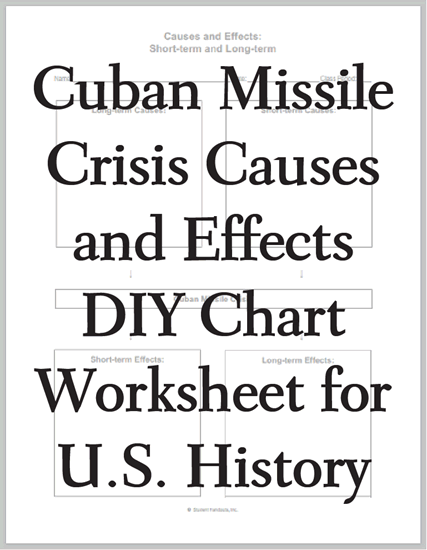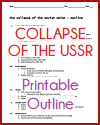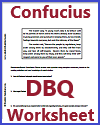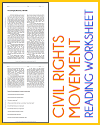Students complete this DIY infographic, listing the short- and long-term causes and effects of the Cuban Missile Crisis. Click here to print. Answers will vary.
Short-Term Causes:
- Placement of Missiles in Cuba: The immediate trigger was the discovery of Soviet nuclear missiles in reach of Cuba in October, 1962. These missiles had the potential to reach U.S. cities, and their deployment was seen as a direct threat to American national security.
Long-Term Causes:
- Cold War Tensions: The broader context was the ongoing Cold War rivalry between the United States and the Soviet Union. This had created a climate of suspicion, competition, and a nuclear arms race.
- U.S. Missiles in Turkey: The United States had previously placed nuclear missiles in Turkey, which bordered the Soviet Union. This move was seen as provocative by the Soviets.
- Cuban Revolution: The Cuban Revolution in 1959 had brought Fidel Castro to power in Cuba. This led to a shift in Cuba's alignment toward the Soviet Union, increasing the geopolitical stakes in the region.
Short-Term Effects:
- Naval Blockade: To prevent further Soviet shipments to Cuba, the U.S. implemented a naval blockade, demanding the removal of the missiles.
- Tense Standoff: For 13 days, the world was on the brink of nuclear war as the U.S. and the Soviet Union engaged in tense negotiations. It was a time of high anxiety and fear of a nuclear conflict.
- Resolution: Ultimately, the crisis was resolved when the U.S. agreed not to invade Cuba and secretly promised to remove its missiles from Turkey. In return, the Soviets removed their missiles from Cuba.
Long-Term Effects:
- Direct communication: In the aftermath of the crisis, the United States and the Soviet Union established a direct hotline (the "red telephone") to improve communication and reduce the risk of misperceptions leading to conflict.
- Arms Control: The Cuban Missile Crisis heightened awareness of the dangers of nuclear brinksmanship. This led to efforts to improve arms control and reduce the risk of nuclear war, including the signing of the Partial Test Ban Treaty in 1963.
- De-Escalation: Both superpowers recognized the need for a more stable and predictable relationship to avoid such crises in the future. This contributed to the policy of détente in the late 1960s and 1970s, characterized by a reduction in Cold War tensions.
- Cuban Impact: While the U.S. did not invade Cuba, it continued to impose a trade embargo, isolating the island nation and contributing to long-term tensions between the two countries.
- Legacy of Caution: The crisis served as a cautionary tale of the dangers of nuclear conflict and influenced U.S. foreign policy and crisis management strategies.
The Cuban Missile Crisis was one of the most perilous moments of the Cold War, and its successful resolution was seen as a triumph of diplomacy. It highlighted the urgent need for superpowers to find ways to manage their differences and prevent nuclear war.
|













